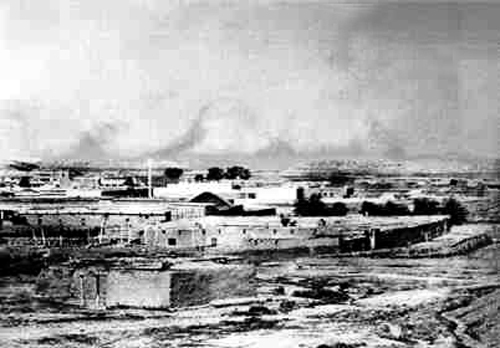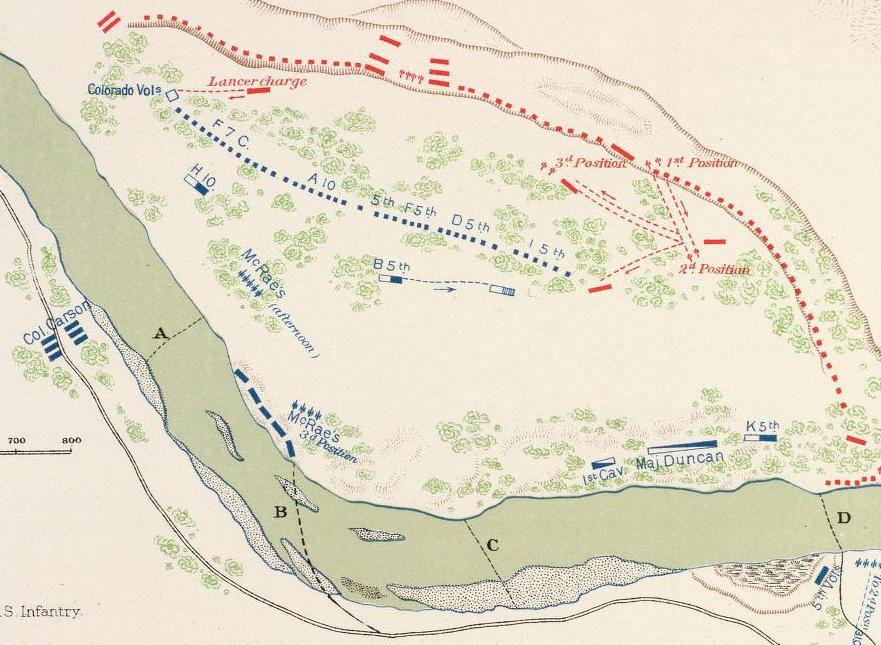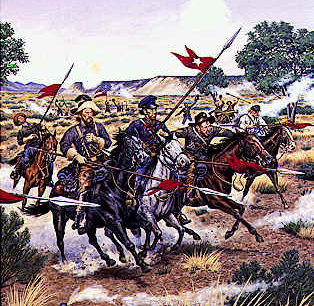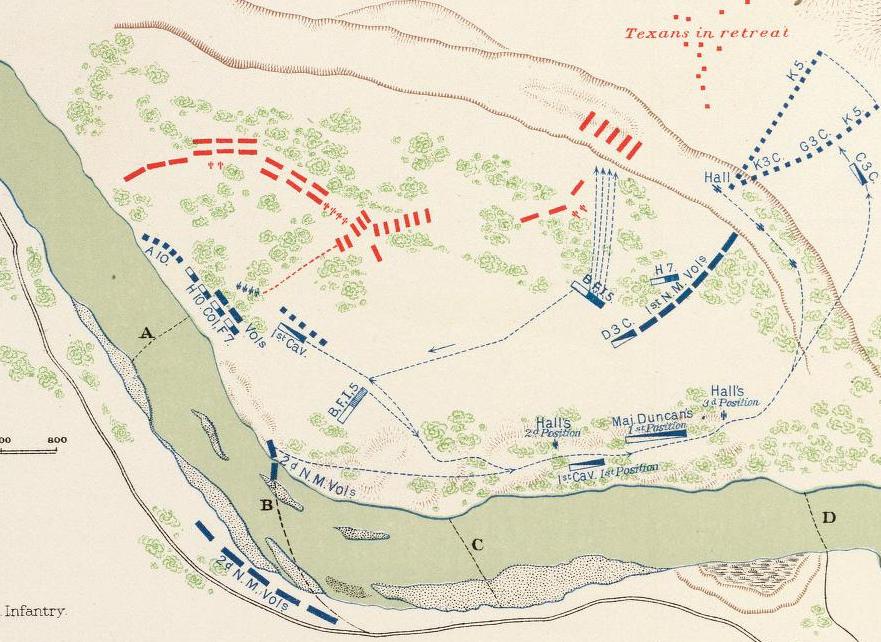Try Amazon Fresh

Find the perfect fit with Amazon Prime. Try Before You Buy.
Battle of Valverde, 1862
Brief Overview
On 20th December 1861 Brigadier General Henry H. Sibley issued a
proclamation claiming New Mexico for the Confederacy. To support his
words, he advanced north in February 1862 following the Rio Grande he
intended to take first Fort Craig (pictured Below), the capital at Santa
Fe, and Fort Union.

Marching with 2,590 ill-equipped men, Sibley neared Fort Craig on 13th
February. Within the fort's walls were around 3,800 Union soldiers led
by Colonel Edward Canby. Unsure of the size of the approaching
Confederate force, Canby employed several ruses, including the use of
wooden "Quaker guns," to make the fort look stronger.
Judging Fort Craig to be too strong to be taken by direct assault,
Sibley remained south of the fort and deployed his men with the goal of
enticing Canby to attack. Though the Confederates remained in position
for three days, Canby refused to leave his fortifications. Short on
rations, Sibley convened a council of war. On the 18th February
following discussions it was decided to cross the Rio Grande, move up
the east bank and capture the ford at Valverde with the goal of severing
Fort Craig's lines of communication to Santa Fe. Advancing, the
Confederates camped to the east of the fort on the night of 20th/21st
February.
It was at this point that one of the most bizarre plans of the war was
hatched by a union officer Capt. James 'Paddy' Graydon - taking a couple
of mules he loaded them with Howitzer shells and set a fuse his plan
was to sneak near the confederate camp and let the hapless mules lose
with the lit fuse and allow them to"make friends" with the confederate
mules - with the hope of taking out the mule train forcing Sibley to
retreat.
Graydon and his accomplices let the mules go and they wandered into the
darkess toward the camp. Satisfied they made their way back however near
ft Craig they heard a noice and to their horror discovered that the
mules had turn tails and followed them back to the fort!! Beating a
hasty retreat trying to get as far away from the explosive ladden mules
as possible. Suddenly the fort sentries saw and heard a large explosion
and a few moments later out of the smoke and darkness came a shamed face
Grayson and his men unhorsed but unharmed.
The next day Canby dispatched a mixed force of cavalry, infantry, and
artillery under Lieutenant Colonel Benjamin Roberts to the ford on the
morning of 21st February. Slowed by his guns, Roberts sent Major Thomas
Duncan ahead with the cavalry to hold the ford. As Union troops were
moving north, Sibley ordered Major Charles Pryon to scout the ford with
four companies from the 2nd Texas Mounted Rifles. Pryon's advance was
supported Lieutenant Colonel William Scurry's 4th Texas Mounted Rifles.
Arriving at the ford they were surprised to find Union troops there.

Quickly taking position in a dry river bed, Pryon called for aid from
Scurry. Opposite, Union guns moved into place on the west bank, while
the cavalry advanced in a skirmish line. Depsite possessing a numerical
advantage, the Union forces did not attempt to assault the Confederate
position. Arriving on the scene, Scurry deployed his regiment to Pryon's
right. Though coming under fire from Union forces, the Confederates
were unable to respond in kind as they were largely equipped with
pistols and shotguns which lacked sufficient range.
Learning of the standoff, Canby departed Fort Craig with the bulk of his
command only leaving a force of militia to guard the post. Arriving on
the scene, he left two regiments of infantry on the west bank and pushed
the remainder of his men across the river. Pounding the Confederate
position with artillery, Union forces slowly gained the upper hand on
the field. Aware of the growing fight at the ford, Sibley also sent
reinforcements in the form of Colonel Tom Green's 5th Texas Mounted
Rifles and elements of the 7th Texas Mounted Rifles.
Sibley never went to the battlefield himself citing he was ill on the
day of the battle, he remained in camp after delegating field command to
Green (Pictured below)- However it was alleged by more than one witness
after the campaign that rather than being ill Sibley had been drunk the
night before the battle and was suffering from the effects the next
morning.

Early in the afternoon, Green authorised an attack by a company of
lancers from the 5th Texas Rifles. Led by Captain Willis Lang, they
surged forward and were met by heavy fire from a company of Colorado
volunteers. Their charge defeated, the remnants of the lancers withdrew.
Lang was so badly wounded in the charge (6/8 gunshot wounds + cannon
wound) he ordered his loyal man-servant to bring him a weapon and he
comitted suicide.

Lang's brave charge was the last use of lances during the civil war.
Assessing the situation, Canby decided against a frontal attack on
Green's line. Instead, he sought to force the Confederate left flank.
Ordering Colonel Christopher "Kit" Carson's untested 1st New Mexico
Volunteers across the river, he advanced them, along with Captain
Alexander McRae's artillery battery, to a forward position.

Seeing the Union assault forming, Green ordered Major Henry Raguet to
lead an attack against the Union right to buy time. Charging forward,
Raguet's men were repulsed and the Union troops began advancing. While
Raguet's men were being turned back, Green ordered Scurry to prepare an
attack on the Union center. Surging forward in three waves, Scurry's men
struck near McRae's battery. In fierce fighting, they succeeded in
taking the guns and shattering the Union line. His position suddenly
collapsing, Canby was forced to order a retreat back across the river
though many of his men had already begun to flee the field.
Valverde cost Canby 111 killed, 160 wounded, and 204 captured/missing.
Sibley's losses totaled 150-230 killed and wounded. Falling back to Fort
Craig, Canby resumed a defensive position. Though he had won a victory
in the field, Sibley still lacked sufficient forces to successfully
attack Fort Craig. Short on rations, he elected to continue north
towards Albuquerque and Santa Fe with the goal of re-provisioning his
army.
Canby, believing his was out-numbered elected not to pursue. Though he
ultimately occupied both Albuquerque and Santa Fe, Sibley was forced to
abandon New Mexico after the Battle of Glorieta Pass and the loss of his wagon train.
Zeke
Glorieta Pass Sources






